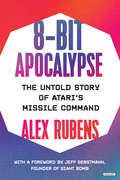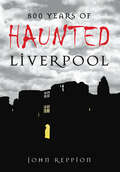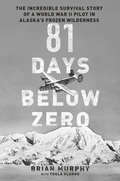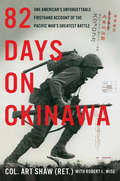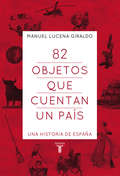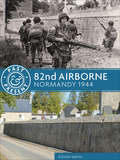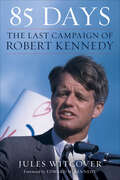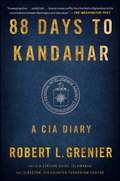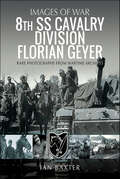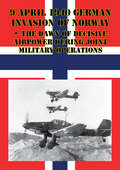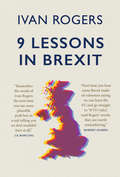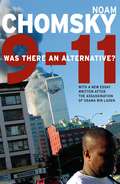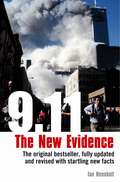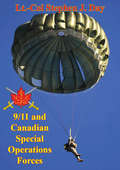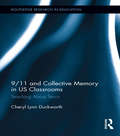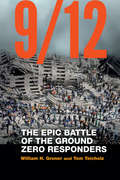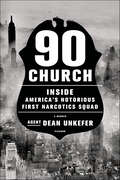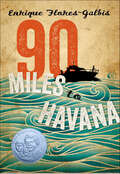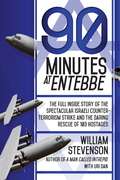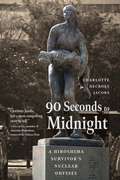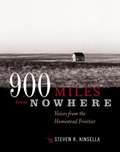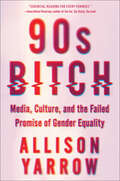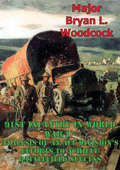- Table View
- List View
8-Bit Apocalypse: The True Story Behind The Classic Video Game
by Alex Rubens Jeff GerstmannThe first history of Atari’s Missile Command, and its unforeseen effects on its creators and the culture Before Call of Duty, before World of Warcraft, before even Super Mario Bros., the video game industry exploded in the late 1970s with the advent of the video arcade. Leading the charge was Atari Inc., the creator of, among others, the iconic game Missile Command. The first game to double as a commentary on culture, Missile Command put the players’ fingers on “the button,” making them responsible for the fate of civilization in a no-win scenario, all for the price of a quarter. The game was a marvel of modern culture, helping usher in both the age of the video game and the video game lifestyle. Its groundbreaking implications inspired a fanatical culture that persists to this day. As fascinating as the cultural reaction to Missile Command were the programmers behind it. Before the era of massive development teams and worship of figures like Steve Jobs, Atari was manufacturing arcade machines designed, written, and coded by individual designers. As earnings from their games entered the millions, these creators were celebrated as geniuses in their time; once dismissed as nerds and fanatics, they were now being interviewed for major publications, and partied like Wall Street traders. However, the toll on these programmers was high: developers worked 120-hour weeks, often opting to stay in the office for days on end while under a deadline. Missile Command creator David Theurer threw himself particularly fervently into his work, prompting not only declining health and a suffering relationship with his family, but frequent nightmares about nuclear annihilation. To truly tell the story from the inside, tech insider and writer Alex Rubens has interviewed numerous major figures from this time: Nolan Bushnell, founder of Atari; David Theurer, the creator of Missile Command; and Phil Klemmer, writer for the NBC series Chuck, who wrote an entire episode for the show about Missile Command and its mythical “kill screen.” Taking readers back to the days of TaB cola, dot matrix printers, and digging through the couch for just one more quarter, Alex Rubens combines his knowledge of the tech industry and experience as a gaming journalist to conjure the wild silicon frontier of the 8-bit ’80s. 8-Bit Apocalypse: The Untold Story of Atari's Missile Command offers the first in-depth, personal history of an era for which fans have a lot of nostalgia.
800 Years of Haunted Liverpool
by John ReppionThis creepy collection of true life tales takes the reader on a tour through the streets, cemeteries, alehouses, attics and docks of Liverpool. Drawing on historical and contemporary sources and containing many tales which have never before been published, it unearths a chilling range of supernatural phenomena, from the Grey Lady of Speke Hall to the ghost of John Lennon airport. Copiously illustrated with photographs, maps and drawings, this book will delight anyone with an interest in the supernatural history of the area. It is the first complete guide to the paranormal history of the region.
81 Days Below Zero: The Incredible Survival Story of a World War II Pilot in Alaska's Frozen Wilderness
by Brian MurphyShortly before Christmas in 1943, five Army aviators left Alaska’s Ladd Field on a test flight. Only one ever returned: Leon Crane, a city kid from Philadelphia with little more than a parachute on his back when he bailed from his B-24 Liberator before it crashed into the Arctic. Alone in subzero temperatures, Crane managed to stay alive in the dead of the Yukon winter for nearly twelve weeks and, amazingly, walked out of the ordeal intact. 81 Days Below Zero recounts, for the first time, the full story of Crane’s remarkable saga. In a drama of staggering resolve with moments of phenomenal luck, Crane learned to survive in the Yukon’s unforgiving landscape. His is a tale of the human capacity to endure extreme conditions and intense lonelinessand emerge stronger than before.
82 Days on Okinawa: One American's Unforgettable Firsthand Account of the Pacific War's Greatest Battle
by Robert L. Wise"A gritty, first-person account. ... One can hear Shaw’s voice as if he were sitting beside you." —Wall Street JournalAn unforgettable soldier’s-eye view of the Pacific War’s bloodiest battle, by the first American officer ashore Okinawa. On Easter Sunday, April 1, 1945, 1.5 million men gathered aboard 1,500 Allied ships off the coast of the Japanese island of Okinawa. The men were there to launch the largest amphibious assault on the Pacific Theater. War planners expected an 80 percent casualty rate.The first American officer ashore was then-Major Art Shaw (1920-2020), a unit commander in the U.S. Army’s 361st Field Artillery Battalion of the 96th Infantry Division, nicknamed the Deadeyes. For the next three months, Shaw and his men served near the front lines of the Pacific’s costliest battle, their artillery proving decisive against a phantom enemy who had entrenched itself in the rugged, craggy island. Over eighty-two days, the Allies fought the Japanese army in a campaign that would claim more than 150,000 human lives. When the final calculations were made, the Deadeyes were estimated to have killed 37,763 of the enemy. The 361st Field Artillery Battalion had played a crucial role in the victory. The campaign would be the last major battle of World War II and a key pivot point leading to the bombings of Hiroshima and Nagasaki, and to the Japanese surrender in August, two months after the siege’s end.Filled with extraordinary details, Shaw’s gripping account gives lasting testimony to the courage and bravery displayed by so many on the hills of Okinawa.
82 objetos que cuentan un país: Una historia de España
by Manuel LucenaUn recorrido excepcional por la historia de España a través de sus objetos. Frente a lo que hacen otras historias de España, este libro propone un camino de estudio distinto, pues rastrea la existencia milenaria del país en su cultura material y emocional. Alejada de cualquier esencialismo, no narra lo que los objetos «son», sino lo que han representado para los españoles a través de los tiempos. Es esta una relación identitaria, pero, por encima de todo, pasional y utilitaria. Los españoles han proyectado en los 82 objetos que componen la obra múltiples contenidos simbólicos. En los textos dedicados a cada uno de ellos hay elementos descriptivos -qué es cada uno-, analíticos -de qué manera se configuró su contexto- y relacionales -de qué forma fueron considerados únicos en cada momento histórico, cómo adquirieron una pátina o configuración determinada-. Pero, sobre todo, portan significado por el aura que contienen, el amorcon que fueron fabricados y la evocación que provocan en nosotros. Prehistoria, España romana, Edad Media, los Austrias, Ilustración, siglo XIX, siglo XX y el tiempo presente son las partes en que está dividido 82 objetos que cuentan un país. Sigue, por tanto, una cronología clásica, aunque puesta al día. El número y selección de los objetos se ha basado en un intento de acumulación densa y en caracterizaciones canónicas procedentes de diversos ámbitos y disciplinas. No asumen distinciones arcaicas entre «alta cultura» y «cultura popular»; tampoco son siempre materialidades concretas, sino en ocasiones difusas y flexibles, pues el ingenio de los españoles se ha plasmado a lo largo de los siglos en los más variados campos del arte y la cultura, la moda, la política, la cartografía, la numismática, la ciencia o la ingeniería. Reseña:«La historia de España por una original vía paralela a los hechos, a través de los objetos que la jalonan.» Miguel Lorenci, Colpisa «Imágenes y textos de calidad que, a modo de rompecabezas bien encajado, nos reflejan como pueblo y promueven una introspección colectiva que sobrecoge, emociona y estimula a partes iguales.»Ignacio Andrade/Carlos Rubio, Interviú
82nd Airborne: Normandy 1944 (Past & Present Series)
by Stephen Smith Simon Forty<p>An account of the heroic D-Day actions of the US Army’s first airborne division in the series that brings World War II battles to life.<p> <p>Since its formation on August 15, 1942, the 82nd Airborne, commanded by Major General Matthew B. Ridgway, trained exhaustively for their new role, which involved parachuting from C-47s and insertion by Waco CG-4A gliders. After participating in the invasion of Sicily and performing night parachute drops onto the Salerno beachhead in September 1943, the bulk of the division left for the United Kingdom and training for D-Day.<p> <p>Reorganized with two new parachute infantry regiments, the 507th and the 508th, joining the 505th, the division dropped onto the Cotentin peninsula between Ste-Mère-Église and Carentan on the night of June 5–6, in a mission codenamed Boston. Their glider-borne component, the 325th GIR, arrived the next day. Widely dispersed on landing, the division overcame its problems and strong German defenses to take the important town of Ste-Mère-Église. Further intense action along the Merderet River ensured that the Utah beachhead wasn’t compromised, and subsequently, the division fought on losing 5,245 troopers killed, wounded, or missing. When withdrawn after 33 days of action, the division could be satisfied it had performed heroically and helped establish the Allied forces’ foothold in France.<p> <p>The Past & Present Series reconstructs historical battles by using photography, juxtaposing modern views with those of the past together with concise explanatory text. It shows how much infrastructure has remained and how much such as outfits, uniforms, and ephemera has changed, providing a coherent link between now and then.<p>
85 Days: The Last Campaign of Robert Kennedy
by Jules WitcoverThe “definitive account” (Washington Post) of Robert F. Kennedy’s seminal presidential campaign.85 Days is veteran Washington journalist Jules Witcover’s masterpiece of political reportage. It brilliantly captures a lost moment in time when the politics of conviction seemed to converge with America’s youth movement in opposition to the Vietnam War. At its center was the charismatic Robert F. Kennedy, brother of the slain President John F. Kennedy. Robert Kennedy’s impassioned opposition to the Vietnam War, and his vision for a more egalitarian United States, launched him on one of the most memorable, though brief, campaigns in U.S. political history.Witcover’s driving narrative follows Kennedy’s campaign throughout the primary season, as Kennedy mulled a run, developed his core issues and supporter base, and shot to the top of the polls, culminating in a victory in California just two days before he was tragically killed. A timeless work of political journalism, 85 Days captures the character and spirit of a man who came to symbolize an unforgettable era in America.
88 Days to Kandahar
by Robert L. GrenierThe First American-Afghan War, a CIA war, was approved by President George W. Bush and directed by the author, Robert Grenier, the CIA station chief in Islamabad. Forging separate alliances with warlords, Taliban dissidents, and Pakistani intelligence, Grenier launched the "southern campaign," orchestrating the final defeat of the Taliban and Hamid Karzai's rise to power in eighty-eight chaotic days.In his gripping narrative, we meet: General Tommy Franks, who bridled at CIA control of "his" war; General "Jafar Amin," a gruff Pakistani intelligence officer who saved Grenier from committing career suicide; Maleeha Lodhi, Pakistan's brilliant ambassador to the US, who tried to warn her government of the al-Qa'ida threat; "Mark," the CIA operator who guided Gul Agha Shirzai to bloody victory over the Taliban; General Ashfaq Pervaiz Kayani, a cautious man who became the most powerful man in Pakistan, struggling with Grenier's demands while trying to protect his country; and Hamid Karzai, the puzzling anti-Taliban insurgent, a man of courage, petulance, and vacillating moods. Grenier's enemies out in front prove only slightly more lethal than the ones behind his own lines. This first war is won despite Washington bureaucrats who divert resources, deny military support, and try to undermine the only Afghan allies capable of winning. Later, as he directed the CIA's role in the Iraq War, Grenier watched the initial victory squandered. His last command was of CIA's CounterTerrorism Center (CTC), as Bush-era terrorism policies were being repudiated, as the Taliban re-emerged in Afghanistan, and as Pakistan descended into fratricidal violence.
8th SS Cavalry Division Florian Geyer (Images of War)
by Ian BaxterCovers the operations of a leading SS Calvary Regiment and describes fighting under desperate conditions on the Eastern Front.Formed in 1942 8th SS Cavalry Division Florian Geyer was soon deployed to the Eastern Front where Hitler’s ambition to conquer Russia was stalling badly. In common with other SS units the Division was responsible for razing towns and villages, poisoning wells and genocide often against unarmed civilians. This scorched earth policy was aimed at hindering the Red Army’s advance. After moving South, the Division took part in the retreat from the Dnieper River before operating in Hungary and Croatia. The end came when trapped in Budapest by Soviet and Romanian forces, the Division was destroyed in December 1944. By the end of the siege only 800 of the 30,000 men in the SS Corps reached German lines. Using many startling contemporary images, this latest book in the Author’s Images of War series vividly illustrates the horror of warfare on the Eastern Front.
9 April 1940 German Invasion Of Norway - The Dawn Of Decisive Airpower During Joint Military Operations
by Major Brian T. BaxleyOperation Weserübung, the German invasion of Norway during the Second World War, is considered by many military historians to be the first joint military operation involving the combined planning and execution of air, land, and sea forces. After a brief introduction and an explanation of the significance of Norway, Chapter Three will analyze the planning process and strategy used by the Germans in late 1939 and early 1940 for devising this joint operation. Chapter Four examines, primarily from an airpower perspective, the plan itself and its execution during the first day of the operation by the Germans, and the British response. Chapter Five determines how German airpower was used, and in particular, what effect the Luftwaffe attack on 9 April against the British Home Fleet had against Britain's campaign strategy to control the North Sea. The final chapter examines three important lessons United States military planners should extract from Operation Weserübung and apply to operations in the 21st century. They are: 1) the joint operation of air, land, and sea assets produce a synergetic effect greater than the sum of their parts; 2) a difficult part of joint operations is the air command and control; and 3) airpower can decisively deny the enemy use of the land or the sea.
9 Lessons In Brexit
by Ivan RogersIn this short, elegant essay, Ivan Rogers, the UK"s former ambassador to the EU, draws up nine lessons for Brexit that we, as a soon-to-be `third country", need to learn from the last few years, if the next few years - indeed the next decade - are not to be even more painful.
9-11: Was There an Alternative?
by Noam ChomskyIn 9-11, published in November 2001 and arguably the single most influential post 9-11 book, internationally renowned thinker Noam Chomsky bridged the information gap around the World Trade Center attacks, cutting through the tangle of political opportunism, expedient patriotism, and general conformity that choked off American discourse in the months immediately following. Chomsky placed the attacks in context, marshaling his deep and nuanced knowledge of American foreign policy to trace the history of American political aggression--in the Middle East and throughout Latin America as well as in Indonesia, in Afghanistan, in India and Pakistan--at the same time warning against America's increasing reliance on military rhetoric and violence in its response to the attacks, and making the critical point that the mainstream media and public intellectuals were failing to make: any escalation of violence as a response to violence will inevitably lead to further, and bloodier, attacks on innocents in America and around the world. This new edition of 9-11, published on the tenth anniversary of the attacks and featuring a new preface by Chomsky, reminds us that today, just as much as ten years ago, information and clarity remain our most valuable tools in the struggle to prevent future violence against the innocent, both at home and abroad.
9.11: Fully Updated and Revised
by Ian HenshallThe original 9/11 Revealed attracted lavish praise from reviewers in the Daily Mail and Sunday Times for the 'huge gaps' it exposed in the official 9/11 story. It became a non-fiction bestseller despite a wall of silence by the broadcast media and condemnation in a special web page set up by the US State Department. Since then the story has produced many sinister new twists, including: Pentagon whistleblowers have accused the 'Independent 9/11 Commission' of lying; long-suppressed eyewitness testimony has been released confirming multiple explosions in the Twin Towers before and during their collapses; the much vaunted video purporting to prove that Flight 77 hit the Pentagon showed nothing at all; and an analysis of terrorist trials and arrests since 2001 indicates that far from the '600 Al Qaeda sleeper cells in the US' (CIA) there were none at all. In this sequel to 9/11 Revealed, Ian Henshall examines the precedents of black operations by the US/UK, from Northern Ireland to Italy, from Vietnam to Kosovo; he looks at the various 9/11 theories, including the latest twists in the official story, and tests them against the evidence. Finally, he asks what might happen when the storm of popular outrage collides with the regime in Washington and London and outlines the radical changes needed if Washington and London are ever again to function as genuine democracies.
9.11: Fully Updated and Revised
by Ian HenshallThe original 9/11 Revealed attracted lavish praise from reviewers in the Daily Mail and Sunday Times for the 'huge gaps' it exposed in the official 9/11 story. It became a non-fiction bestseller despite a wall of silence by the broadcast media and condemnation in a special web page set up by the US State Department. Since then the story has produced many sinister new twists, including: Pentagon whistleblowers have accused the 'Independent 9/11 Commission' of lying; long-suppressed eyewitness testimony has been released confirming multiple explosions in the Twin Towers before and during their collapses; the much vaunted video purporting to prove that Flight 77 hit the Pentagon showed nothing at all; and an analysis of terrorist trials and arrests since 2001 indicates that far from the '600 Al Qaeda sleeper cells in the US' (CIA) there were none at all. In this sequel to 9/11 Revealed, Ian Henshall examines the precedents of black operations by the US/UK, from Northern Ireland to Italy, from Vietnam to Kosovo; he looks at the various 9/11 theories, including the latest twists in the official story, and tests them against the evidence. Finally, he asks what might happen when the storm of popular outrage collides with the regime in Washington and London and outlines the radical changes needed if Washington and London are ever again to function as genuine democracies.
9/11 And Canadian Special Operations Forces: How ‘40 Selected Men’ Indelibly Influenced The Future Of The Force
by Lt.-Col Stephen J. DayIn less than two decades, Canadian Special Operations Forces (CANSOF) grew from a 100-man hostage-rescue unit to a 2,500-person Command capable of prosecuting missions across the special operations spectrum. The seminal event causing this transformation is examined within this monograph. The common narrative explaining the rise of Canadian Special Operations Forces Command (CANSOFCOM) states that 9/11 is the seminal event. Herein, a new narrative is proposed. One that posits the 2001-02 deployment of a 40-man CANSOF Task Force to Operation Enduring Freedom (OEF) is the seminal event. This Task Force's disproportionately positive impact on the Canadian national scene caused key national actors to take note of the strategic utility of special operations forces. Twenty-four interviews with defence and security subject matter experts from the political, federal public service, military and academic domains, as well as two leading Canadian national journalists provide unique insights into CANSOF's ascendancy. Analyzing published defence policy since World War II and Canada's 20-year experience with her national counter-terrorism task force prove two key points. First, defence policy is extant, consistently expressing the requirement for an irregular capability for the conduct of operations in asymmetrical environments. Therefore, 9/11 did not change Government of Canada (GoC) expectations per se. Second, the one-year CANSOF OEF commitment produces a highly positive national strategic effect for the GoC. As a result, in less than a decade CANSOF transitions from a single, domestically focused, national counter-terrorism task force to where today CANSOFCOM is employed as a distinct element of national military power. This transformation from a single strategic resource to a strategically relevant, 'hard power' option currently provides the GoC with greater strategic choice when she looks to deploy military forces alongside her allies.
9/11 and Collective Memory in US Classrooms: Teaching About Terror (Routledge Research in Education #124)
by Cheryl Lynn DuckworthWhile current literature stresses the importance of teaching about the 9/11 attacks on the US, many questions remain as to what teachers are actually teaching in their own classrooms. Few studies address how teachers are using of all of this advice and curriculum, what sorts of activities they are undertaking, and how they go about deciding what they will do. Arguing that the events of 9/11 have become a "chosen trauma" for the US, author Cheryl Duckworth investigates how 9/11 is being taught in classrooms (if at all) and what narrative is being passed on to today’s students about that day. Using quantitative and qualitative data gathered from US middle and high school teachers, this volume reflects on foreign policy developments and trends since September 11th, 2001 and analyzes what this might suggest for future trends in U.S. foreign policy. The understanding that the "post-9/11 generation" has of what happened and what it means is significant to how Americans will view foreign policy in the coming decades (especially in the Islamic World) and whether it is likely to generate war or foster peace.
9/12: The Epic Battle of the Ground Zero Responders
by William H. Groner Tom Teicholz9/12 is the saga of the epic nine-year legal battle waged by William H. Groner against the City of New York and its contractors on behalf of the more than ten thousand first responders who became ill as a result of working on the Ground Zero cleanup. These first responders—like AT&T Disaster Relief head Gary Acker and New York Police Department detectives Candiace Baker, Thomas Ryan, and Mindy Hersh—rushed to Ground Zero and remained to work on the rescue and recovery mission, which lasted for the next nine months. Their selfless bravery and humanity were rewarded with horrible health issues resulting from the toxic stew of chemicals present in the dust and debris that government officials such as Mayor Rudy Giuliani and EPA chief Christine Todd Whitman had assured them was safe. Groner, a lead attorney in the mass tort litigation, fought for their illnesses to be acknowledged and for them to receive validation and closure, as well as for compensation—an eventual aggregate award of more than $800 million. As detailed in 9/12, the battle for the Ground Zero responders was waged not only in the courtroom but also in the press, in medical and scientific research centers, and among politicians at the local, state, and federal levels, as well as in the halls of Congress to pass the Zadroga Health and Compensation Act. 9/12 weaves together Groner’s firsthand account with glimpses into the first responders’ lives as they try to understand and overcome their illnesses. The result is an intimate look into their battles—physical, mental, and legal—that will leave you cheering for these heroes who, in spite of everything, would do it all again. Told by Groner and journalist Tom Teicholz, 9/12 is the story of the brave public servants who showed up when their country needed them most, of their fight for redress, and of their victory in the face of the seemingly insurmountable.
90 Church: Inside America's Notorious First Narcotics Squad
by Dean UnkeferMAD MEN MEETS THE WIRE IN THIS GRIPPING TRUE-CRIME MEMOIR BY A FORMER AGENT AT THE FEDERAL BUREAU OF NARCOTICS IN 1960s NEW YORKBefore Nixon famously declared a "war on drugs," there was the Federal Bureau of Narcotics. New York City in the mid-1960s: The war in Vietnam was on the nation's tongue—but so is something else. Clandestine and chaotic, but equally ruthless, the agents of the Bureau were feared by the Mafia, dealers, pimps, prostitutes—anyone who did his or her business on the streets. With few rules and almost no oversight, the battle-hardened agents of the bureau were often more vicious than the criminals they chased. Agent Dean Unkefer was a naive kid with notions of justice and fair play when he joined up. But all that quickly changes once he gets thrown into the lion's den of 90 Church, the headquarters of the Federal Bureau of Narcotics, where he is shocked to see the agents he revered are often more like thugs than lawmen. When he finally gets the chance to prove his mettle by going undercover in the field, the lines become increasingly blurred. As he spirals into the hell of addiction and watches his life become a complex balancing act of lies and half-truths, he begins to wonder what side he is really on. 90 Church is both the unbelievable memoir of one man's confrontation with the dark corners of the human experience and a fascinating window into a little-known time in American history. Learn the story of the agents who make the DEA look like choirboys.
90 Houses of the Twenties: Cottages, Bungalows and Colonials (Dover Architecture)
by Jens Pedersen Daniel D. ReiffThis outstanding house plan catalog from a prominent Midwestern builder was issued on the eve of the Great Depression. Its full-color, beautifully realistic illustrations depict colonials, bungalows, duplexes, and other residences, accompanied by floor plans and detailed descriptions of interiors. A nostalgic look back at the way homes were constructed during the 1920s, this volume offers an authentic resource for modern home restorers, builders, and interior designers and a splendid browsing book for fans of architecture, advertising, and Americana. Architectural historian Daniel D. Reiff provides an informative Introduction.
90 Miles to Havana
by Enrique Flores-GalbisWhen Julian's parents make the heartbreaking decision to send him and his two brothers away from Cuba to Miami via the Pedro Pan operation, the boys are thrust into a new world where bullies run rampant and it's not always clear how best to protect themselves.90 Miles to Havana is a 2011 Pura Belpre Honor Book for Narrative and a 2011 Bank Street - Best Children's Book of the Year.
90 Minutes at Entebbe: The Full Inside Story of the Spectacular Israeli Counterterrorism Strike and the Daring Rescue of 103 Hostages
by William Stevenson Uri DanThe incredible story of an Israeli mission that rescued 103 hostages from a hijacked jetliner.On June 27, 1976, Air France Flight 139 was hijacked by terrorists and flown to Entebbe Airport in Uganda. In the following agonizing days, Israeli passengers were singled out and held hostage. A week later on July 4, one hundred Israeli commandos raced 2,500 miles from Israel to Entebbe, landed in the middle of the night, and in a heart-stopping mission that lasted ninety minutes, killed all guerillas and freed 103 hostages.In captivating detail, Stevenson provides a fast-paced hour-by-hour narration from the hijacking to the final ninety-minute mission. In addition to discussing the incredible rescue itself, Stevenson also covers the political backdrop behind the hijacking, especially Ugandan President Idi Amin’s support for the hijackers, which marked one of the first times a leader of a nation had backed terrorist activities. An illustration of one nation’s undying spirit, heroism, and commitment to its people in the face of threat, Operation Thunderbolt has become a legendary antiterrorist tale.Although first written in 1976 (and published within weeks of the event), Stevenson’s account presents this act of terrorism in a way that is still relevant in our modern-day political climate. A factual account of what could easily be read as sensational fiction, 90 Minutes at Entebbe will inspire, encourage, and instill hope in all readers.Skyhorse Publishing, as well as our Arcade imprint, are proud to publish a broad range of books for readers interested in history--books about World War II, the Third Reich, Hitler and his henchmen, the JFK assassination, conspiracies, the American Civil War, the American Revolution, gladiators, Vikings, ancient Rome, medieval times, the old West, and much more. While not every title we publish becomes a New York Times bestseller or a national bestseller, we are committed to books on subjects that are sometimes overlooked and to authors whose work might not otherwise find a home.
90 Seconds to Midnight: A Hiroshima Survivor's Nuclear Odyssey
by Charlotte DeCroes Jacobs90 Seconds to Midnight tells the gripping and thought-provoking story of Setsuko Nakamura Thurlow, a thirteen-year-old girl living in Hiroshima in 1945, when the city was annihilated by an atomic bomb. Struggling with grief and anger, Thurlow set out to warn the world about the horrors of a nuclear attack in a crusade that has lasted seven decades. In 2015 Thurlow sparked a rallying cry for activists when she proclaimed at the United Nations, &“Humanity and nuclear weapons cannot coexist.&” With that, she shifted the global discussion from nuclear deterrence to humanitarian consequences, the key in crafting the landmark Treaty on the Prohibition of Nuclear Weapons. Regarded as the conscience of the antinuclear movement, Thurlow accepted the 2017 Nobel Peace Prize on behalf of the International Campaign to Abolish Nuclear Weapons. With the fate of humanity at stake and with the resolve of her samurai ancestors, Thurlow challenged leaders of the nuclear-armed states. On January 22, 2021, the Treaty on the Prohibition of Nuclear Weapons went into effect, banning nuclear weapons under international law. Critical historical events need a personal narrative, and Thurlow is such a storyteller for Hiroshima. 90 Seconds to Midnight recounts Thurlow&’s ascent from the netherworld where she saw, heard, and smelled death and her relentless efforts to protect the world from an unspeakable fate. Knowing she would have to live with those nightmares, Thurlow turned them into a force to impel people across the globe to learn from Hiroshima, to admit that yes, it could happen again—and then to take action.
900 Miles from Nowhere: Voices from the Homestead Frontier
by Steven R. KinsellaIt was on the vast American prairie that people from around the world seized the opportunity for personal and economic freedom promised by free land. Traveling across oceans and continents, these hard-nosed, pragmatic people began arriving in the 1860s with shovels and ploughs, convinced they were part of something important. They were. Putting hand to plough and breaking the sod for their first crude homes, these hardy settlers left an indelible thumbprint on American history and on the country's character. Though many of their ventures ended in failure, their risks permanently enhanced the nation's diversity and its sense of independence and resourcefulness. 900 Miles from Nowhere is the heartfelt chronicle of the daily lives and personal struggles of Great Plains homesteaders, told in their own voices through many never-before-published letters, diaries, and photographs. Believing absolutely that they could control their own destiny, they bet everything they owned, even in the face of insurmountable obstacles. This is the remarkable and ever-inspiring story of life on the grasslands that stretch from Canada to Mexico.
90s Bitch: Media, Culture, and the Failed Promise of Gender Equality
by Allison Yarrow“Allison Yarrow takes you back to the era of Anita Hill and Monica Lewinsky and Tonya Harding and examines how the media fueled America’s sexism.”—BustleTo understand how we got here, we have to rewind the VHS tape. 90s Bitch tells the real story of women and girls in the 1990s, exploring how they were maligned by the media, vilified by popular culture, and objectified in the marketplace. Trailblazing women like Hillary Clinton, Anita Hill, Madeleine Albright, Janet Reno, and Marcia Clark were undermined. Newsmakers like Britney Spears, Monica Lewinsky, Tonya Harding and Lorena Bobbitt were shamed and misunderstood. The advent of the twenty-four-hour news cycle reinforced society's deeply entrenched misogyny. Meanwhile, marketers hijacked feminism, sold “Girl Power,” and poisoned a generation. Today echoes of 90s “bitchification” still exist everywhere. To understand why, we must revisit and interrogate the 1990s—a decade in which empowerment was twisted into objectification, exploitation, and subjugation. Award–winning journalist Allison Yarrow’s timely examination is a must-read for anyone trying to understand twenty-first century sexism and end it for the next generation.“Yarrow’s biting autopsy of the decade scrutinizes the way society reduced—or “bitchified”—women . . . Direct quotes from politicians, journalists and comedians about the women provide the most jarring, oh-my-god-that-really-happened portions of Yarrow’s decade excavation.” —Pittsburg Post-Gazette“Allison Yarrow is a feminist and a muckraker in the tradition of Betty Friedan, Naomi Klein, and bell hooks.” —Steve Almond, author of Bad Stories: What the Hell Just Happened to Our Country“Yarrow is a skillful scene setter.” —The Los Angeles Review of Books“‘Essential reading for every feminist.” Anne Helen Petersen, author of Too Fat, Too Slutty, Too Loud
91st Infantry In World War I--Analysis Of An AEF Division's Efforts To Achieve Battlefield Success [Illustrated Edition]
by Major Bryan L. WoodcockIncludes The Americans in the First World War Illustration Pack - 57 photos/illustrations and 10 mapsThe 91st Infantry Division was a National Army Division created prior to World War I. Based at Camp Lewis, Washington, it was composed of draftees from the northwestern United States. Following a train up that lasted less than one year, this division departed for Europe in June 1918.In France, the 91st Division conducted additional training, but the AEF pushed it to the front lines before it was completed. In its first combat experience, the 91st Division fought on the front lines of the Meuse-Argonne. In the first days of this battle, the 91st Division, although inexperienced, gained more ground than any other American division. However, it paid a heavy price in terms of American lives. The AEF subsequently assigned the division to work under French command in the battle of Ypres-Lys in Belgium.This thesis examines the division leadership's ability to execute necessary warfighting functions and combined arms operations in the challenging environment of 1917-1918. The division was tested and accomplished a significant amount, but it also suffered many deficiencies and was forced to learn hard lessons in combat.
